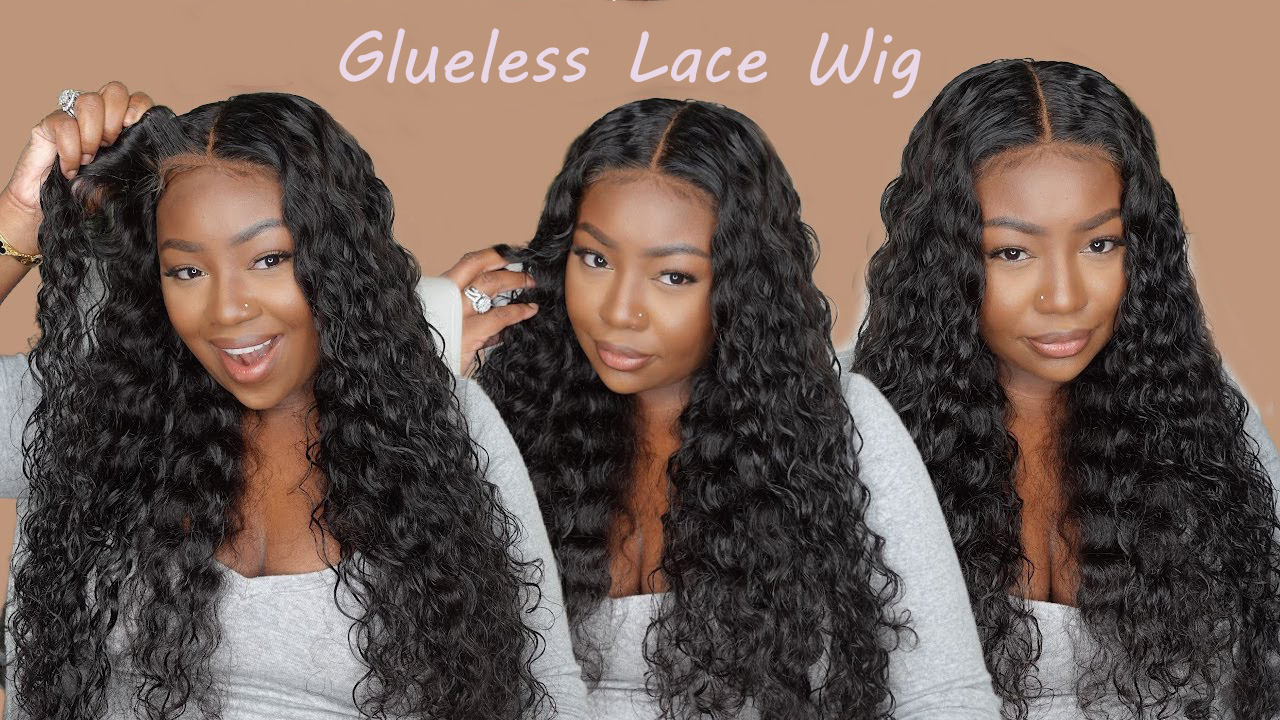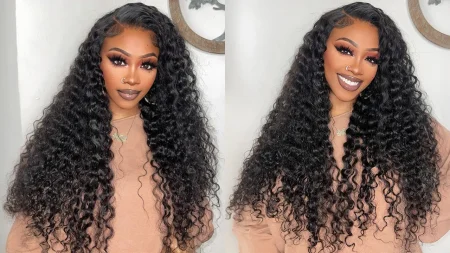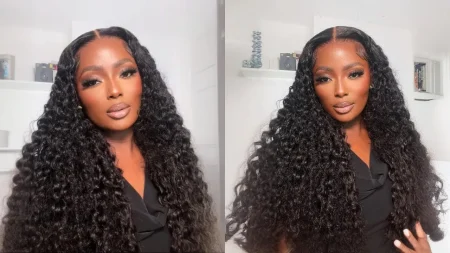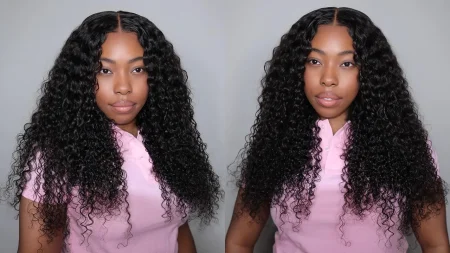Among the various wig options available, glueless lace wigs have gained immense popularity. Offering a seamless and natural-looking hairline without the need for adhesive products, glueless lace wigs have revolutionized the way we can transform our hair effortlessly. In this comprehensive guide, we will explore the wonders of glueless lace wigs, from understanding their construction and application methods to maintenance and styling tips.
I. Fully Understand the Glueless Lace Wigs.
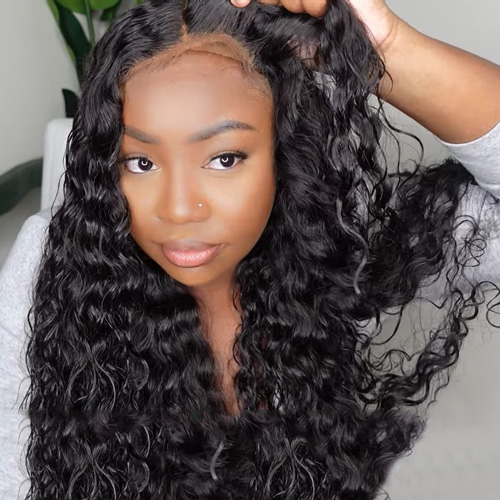
A. What are Glueless Lace Wigs?
Glueless lace wigs are a type of wig construction designed to provide a natural-looking hairline without the need for adhesive products such as glue or tape. These wigs are crafted using a delicate lace material that mimics the appearance of the scalp, allowing for a seamless and undetectable blend with your natural hairline. The lace is typically located at the front of the wig, extending from ear to ear, and sometimes covers the entire wig cap for added versatility in styling.
B. Types of Lace Material.
Swiss Lace: Swiss lace is known for its fine and delicate texture. It is soft, thin, and offers a high level of flexibility, which makes it comfortable to wear. Swiss lace is also highly breathable, allowing for proper airflow to the scalp.
French Lace: French lace is slightly thicker and more durable than Swiss lace. It provides a good balance between durability and natural appearance. The holes in French lace are slightly larger, making it less fragile but still effective in creating a realistic hairline.
HD Lace: High-definition (HD) lace is a newer type of lace material that offers an even more natural look. It is ultra-thin and blends seamlessly with various skin tones. HD lace is virtually undetectable when applied correctly.
C. Different Cap Construction Options.
Full Lace Wigs: Full lace wigs feature a lace cap construction that covers the entire head. The lace allows for versatile styling options, including parting the hair anywhere on the wig.
Lace Front Wigs: Lace front wigs have lace at the front hairline, extending from ear to ear. The rest of the wig cap is typically constructed with a more durable material, such as a stretchy net or monofilament. Lace front wigs provide a natural-looking hairline and are more affordable than full lace wigs.
360 Lace Wigs: 360 lace wigs combine the benefits of both full lace wigs and lace front wigs. They feature a circular lace strip around the entire perimeter of the wig, allowing for versatile styling and the option to wear the hair in a high ponytail.
D. Advantages of Glueless Lace Wigs.
Natural Appearance: Glueless lace wigs provide a realistic hairline, making them virtually undetectable when properly applied. The lace material blends seamlessly with the scalp, creating the illusion of hair growing from your own head.
Comfort and Breathability: The lace material used in glueless lace wigs is lightweight and breathable, allowing for proper ventilation to the scalp. This makes them more comfortable to wear, especially for longer durations.
Versatile Styling: With glueless lace wigs, you can style your hair in various ways, including parting it anywhere on the wig, styling in updos, and even pulling the hair back into a ponytail. The versatility of these wigs allows for creative freedom and the ability to change hairstyles effortlessly.
Easy Application and Removal: As the name suggests, glueless lace wigs eliminate the need for adhesive products. This makes the application and removal process quick and hassle-free, reducing the risk of damage to your natural hair and scalp.
Protection for Natural Hair: Glueless lace wigs can act as a protective style for your natural hair, shielding it from heat, styling products, and environmental damage. They allow your hair to grow and rest while still maintaining a stylish and put-together look.
II. Preparing for a Glueless Lace Wig.
Before you embark on your glueless lace wig journey, it’s important to make necessary preparations to ensure a seamless and comfortable experience. From choosing the right wig to preparing your natural hair for application, these steps will set the foundation for a flawless transformation.
A. Choosing the Right Wig.
Determine the Desired Style: Consider the hairstyle, length, texture, and color you want to achieve with your glueless lace wig. Whether you prefer straight, wavy, curly, or kinky hair, select a wig that aligns with your desired look.
Select the Hair Type: Glueless lace wigs are available in a variety of hair types, including human hair, synthetic hair, and blended options. Human hair offers the most natural appearance and allows for heat styling, while synthetic hair is low maintenance and comes in pre-styled options.
Consider the Wig Density: Wig density refers to the amount of hair present on the wig. Choose a density level that suits your preferences and desired volume. Higher density wigs provide a fuller look, while lower density wigs offer a more natural and lightweight feel.
B. Determining the Correct Wig Size.
Measure Your Head: Use a soft measuring tape to measure the circumference of your head, starting at the hairline and going around the back. Note down the measurement in inches or centimeters.
Check the Wig Size Chart: Compare your head circumference measurement with the wig size chart provided by the wig manufacturer. This will help you determine the appropriate wig size (small, medium, large, etc.) that will fit your head comfortably.
C. Preparing Natural Hair for Wig Application.
Cleanse and Condition: Before wearing a glueless lace wig, ensure that your natural hair and scalp are clean and conditioned. This promotes a healthy environment for your hair and helps maintain the wig’s longevity.
Moisturize and Seal: Apply a moisturizer or leave-in conditioner to your natural hair to keep it hydrated. Seal in the moisture with a light oil or natural butter to prevent dryness.
Protect Your Hairline: If you have sensitive or fragile edges, consider applying a light layer of oil or gel around your hairline to provide a protective barrier. This can help prevent friction and potential damage when wearing the wig.
D. Customization and Personalization Options.
Pre-Plucked Hairline: Some glueless lace wigs come with pre-plucked hairlines, which mimic the natural appearance of baby hairs and create a more realistic look. If your wig does not come pre-plucked, you can customize the hairline by plucking a few hairs along the edge of the wig to create a softer and more natural hairline.
Bleaching the Knots: The knots on the lace of a wig can be bleached to make them less visible. This technique helps create a more seamless and natural-looking hairline. However, it’s important to exercise caution when bleaching knots to avoid damaging the wig.
III. Application Methods for Glueless Lace Wigs.
One of the significant advantages of glueless lace wigs is the absence of adhesive products. These wigs can be securely and comfortably worn using different application methods. Whether you prefer an elastic band, adjustable straps, or combs and clips, there is a method suitable for your needs. Let’s explore the various application methods for glueless lace wigs.
A. Elastic Band Method.
Step-by-Step Application:
a. Secure the wig cap: Wear a wig cap that matches your skin tone to create a smooth base for the wig. Ensure that your natural hair is tucked under the cap.
b. Adjust the wig cap: Position the wig cap so that it sits comfortably on your head and covers your hairline.
c. Attach the elastic band: Many glueless lace wigs come with an adjustable elastic band sewn inside the wig cap. Adjust the elastic band to fit snugly around your head, providing a secure fit.
d. Secure the wig: Place the wig on your head, aligning the front hairline with your natural hairline. Adjust the wig to ensure it fits securely and evenly around your head.
e. Secure the wig with the elastic band: Pull the elastic band over your head and adjust the tension to your comfort level. The elastic band will hold the wig in place without the need for adhesive.
B. Adjustable Straps Method.
a. Prepare the wig cap: Wear a wig cap that matches your skin tone, ensuring that your natural hair is tucked under the cap.
b. Position the wig cap: Adjust the wig cap so that it covers your hairline and fits comfortably on your head.
c. Secure the wig cap: Many glueless lace wigs have adjustable straps located at the back of the wig cap. Fasten the straps to tighten or loosen the wig according to your preference, ensuring a secure fit.
d. Place the wig on your head: Position the wig on your head, aligning the front hairline with your natural hairline.
e. Adjust the straps: Secure the wig by tightening or loosening the adjustable straps to achieve a snug fit. The straps will keep the wig in place without the need for adhesive.
C. Comb and Clip Method.
a. Prepare your natural hair: Style your natural hair in a way that creates a flat base for the wig. You can braid your hair, create cornrows, or twist it into a bun.
b. Position the wig cap: Wear a wig cap that matches your skin tone and covers your natural hair completely.
c. Attach combs and clips: Glueless lace wigs often come with built-in combs or clips along the hairline and sides. Insert the combs into your natural hair or attach the clips onto the wig cap to secure the wig in place.
d. Place the wig on your head: Align the front hairline of the wig with your natural hairline and gently place the wig on your head.
e. Adjust the combs and clips: Ensure that the combs or clips are securely fastened to your natural hair or the wig cap. This will keep the wig in place throughout the day.
D. Tips for a Secure and Comfortable Fit.
Wig Cap: Wear a wig cap to provide a smooth and even base for the wig. This helps to prevent friction and ensures a more secure fit.
Wig Adjustment: Adjust the wig straps, elastic band, combs, or clips to achieve a snug but comfortable fit. Avoid pulling the wig too tightly, as it can cause discomfort or damage to the wig or your natural hair.
Wig Positioning: Align the front hairline of the wig with your natural hairline for a seamless and natural-looking blend. Ensure that the wig is centered on your head and sits evenly.
IV. Caring for Glueless Lace Wigs.
Proper care and maintenance are essential for prolonging the lifespan and maintaining the natural beauty of your glueless lace wig. By following a regular cleaning and styling routine, storing it correctly, and protecting the hairline, you can enjoy your wig for an extended period. Let’s delve into the essential care tips for glueless lace wigs.
A. Washing and Conditioning Techniques.
Detangle: Before washing your wig, gently detangle it using a wide-toothed comb or a wig brush. Start from the ends and work your way up to minimize hair breakage.
Shampooing: Fill a basin with lukewarm water and add a small amount of wig shampoo. Submerge the wig into the water and gently swirl it around. Avoid rubbing or wringing the hair, as this can cause tangling or damage.
Rinsing: Rinse the wig thoroughly with lukewarm water to remove all the shampoo. Ensure that no residue is left in the hair.
Conditioning: Apply a wig conditioner to the hair, avoiding the lace and knots. Leave the conditioner on for a few minutes to hydrate and nourish the hair, then rinse it out with lukewarm water.
Drying: Gently pat the wig with a towel to remove excess water. Avoid rubbing or wringing the hair. Place the wig on a wig stand or a wig head to air dry naturally. Avoid using heat styling tools or blow dryers, as excessive heat can damage the hair fibers.
B. Storing the Wig Properly.
Detangling and Brushing: Before storing the wig, ensure that it is thoroughly detangled. Use a wide-toothed comb or a wig brush to gently comb through the hair, starting from the ends and working your way up.
Wig Stand or Head: Place the wig on a wig stand or a wig head to maintain its shape and prevent tangling. This helps the wig retain its style and prevents unnecessary pulling or stress on the hair fibers.
Covering: If you are storing the wig for an extended period, consider covering it with a wig net or a breathable bag to protect it from dust and dirt.
Avoid Direct Sunlight: Store the wig in a cool and dry place, away from direct sunlight. Prolonged exposure to sunlight can cause the color of the hair to fade.
C. Detangling and Styling Tips.
Detangling: To detangle the wig, start at the ends and gently work your way up, using a wide-toothed comb or a wig brush. Avoid pulling or tugging too forcefully, as this can cause shedding or damage to the hair.
Heat Styling: If your glueless lace wig is made of human hair, you can use heat styling tools such as flat irons, curling irons, or hot rollers to create different hairstyles. Remember to use a heat protectant spray before applying heat to the hair to minimize damage.
Avoid Excessive Styling: Excessive heat styling or manipulation can lead to hair damage or loss of the wig’s natural luster. Limit the use of heat styling tools and opt for alternative styling methods such as flexi-rods, braids, or bantu knots to achieve different looks.
Avoid Sleeping with the Wig: It’s recommended to remove the wig before going to bed to prevent tangling and minimize friction.
D. Protecting the Hairline and Edges.
Avoid Tension and Pulling: Be mindful of the tension and tightness when wearing your glueless lace wig, as excessive pulling or tension can strain your hairline and edges. Ensure that the wig is secured comfortably without causing discomfort or stress on your natural hair.
Use Edge Control Products: Apply a small amount of edge control gel or cream along the hairline to smooth and tame any flyaways. This helps to protect the hairline and maintain a polished look.
Take Breaks: Give your natural hair and edges a break from wearing the wig continuously. Take regular intervals without the wig to allow your hair to breathe and prevent any potential damage.
V. Troubleshooting and Common Challenges with Glueless Lace Wigs.
While glueless lace wigs offer convenience and versatility, you may encounter certain challenges during their use. Understanding how to troubleshoot common issues will help you overcome these obstacles and ensure a seamless experience with your wig. Here are some common challenges and tips for addressing them:
A. Dealing with Slippage or Shifting.
Adjust the Straps or Elastic Band: If your wig is slipping or shifting, check the adjustable straps or elastic band and tighten them to achieve a more secure fit.
Use Wig Clips: Adding additional wig clips or combs to the wig can provide extra support and prevent slippage. Insert the clips into your natural hair or attach them onto the wig cap in strategic areas for added security.
B. Addressing Itching or Irritation.
Cleanse and Moisturize the Scalp: Before wearing the wig, ensure your scalp is clean and moisturized to minimize itching. Use a gentle scalp cleanser and follow up with a lightweight moisturizer or oil.
Avoid Harsh Chemicals: Ensure that any products you use on your natural hair or scalp do not contain harsh chemicals that may cause irritation. Opt for gentle, hypoallergenic products whenever possible.
Proper Ventilation: If you experience itching or discomfort due to lack of airflow, consider using a wig cap or wig liner made of breathable materials to promote better ventilation.
C. Tackling Shedding or Tangling.
Gentle Handling: Handle the wig with care to minimize shedding and tangling. Avoid rough brushing or combing, and use a wide-toothed comb or wig brush specifically designed for wigs to detangle the hair.
Proper Storage: Store the wig on a wig stand or a wig head to maintain its shape and prevent tangling. Avoid storing it in a crowded or tangled state, as this can lead to excessive shedding.
D. Restoring the Wig’s Freshness and Luster.
Washing and Conditioning: Regularly wash and condition your wig to remove product buildup and restore its freshness. Use wig-specific shampoo and conditioner, and follow the recommended care instructions provided by the manufacturer.
Deep Conditioning Treatments: Periodically treat your wig with deep conditioning masks or treatments to nourish and revive the hair fibers. This helps to maintain its natural luster and prevent dryness.
Avoid Overstyling: Excessive heat styling or manipulation can cause the wig to lose its shine and become dull. Limit the use of heat styling tools and opt for non-heat styling methods whenever possible.
The Top 2 Glueless Lace Wig Picks You Must Consider.
Water Wave Glueless Wig 4×4 5×5 13×4 HD Lace Wet and Wavy Human Hair Wig
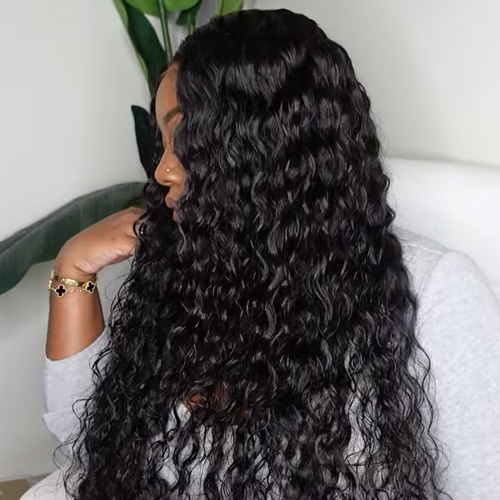
The Water Wave Glueless Wig is a versatile and natural-looking wig made from high-quality human hair. It features a 4×4, 5×5, or 13×4 lace frontal, constructed with HD lace for an undetectable hairline. The water wave texture gives a soft and bouncy look, mimicking the natural waves of wet and wavy hair. With the glueless design, you can wear this wig without the need for adhesive products, providing a comfortable and secure fit. Perfect for those who desire a convenient and realistic hair transformation, the Water Wave Glueless Wig offers flexibility in styling and is available in various lengths and densities.
Water Wave Glueless Bob Wig 4×4 13×4 Undetectable Lace Front Short Human Hair Wig

The Water Wave Glueless Bob Wig is a short and stylish wig option that offers the beauty of water wave hair texture in a bob length. Made from high-quality human hair, this wig features a glueless 4×4 or 13×4 undetectable lace front construction, providing a natural-looking hairline and easy styling versatility. The water wave pattern adds volume and movement to the hair, giving a vibrant and youthful look. With its glueless design, you can wear this wig comfortably and securely without the need for adhesive products. Whether for a casual day out or a special occasion, the Water Wave Glueless Bob Wig is a fashionable choice.
In A Nutshell.
Glueless lace wigs have become a game-changer for individuals looking to transform their hairstyles with ease and confidence. With their seamless application, natural appearance, and versatility, these wigs have gained popularity among wig enthusiasts and hairstylists alike. By following the guidelines and tips provided in this ultimate guide, you can embark on your glueless lace wig journey and experience the freedom of effortlessly changing your look. Remember, the key to maintaining a flawless and long-lasting wig is proper care, styling, and a touch of personal flair.



